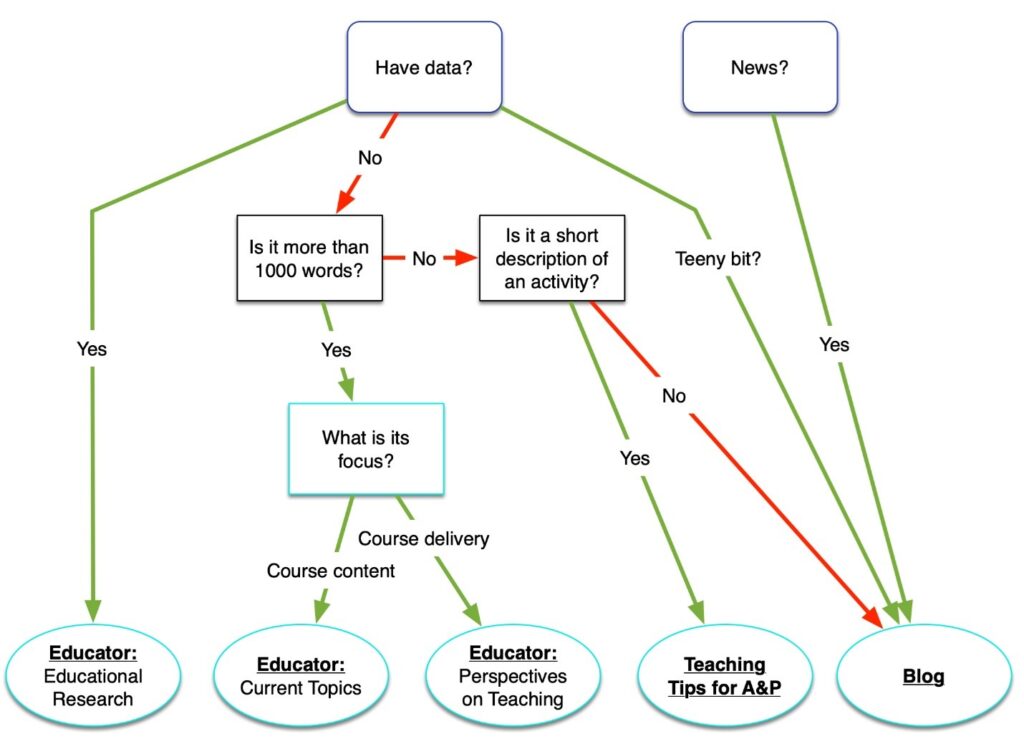Submission Guidelines

A. OVERVIEW
The HAPS Educator welcomes submissions of at least 1000 words relevant to Anatomy and Physiology Education. Authors do not have to be members of HAPS and there is no fee associated with publication in the journal. All HAPS Educator articles are peer-reviewed.
Submissions must be directed towards one of three categories:
- HAPS Educator Educational Research: These papers discuss pedagogical research projects supported by robust data, and usually include introduction, materials and methods, results and discussion sections. However, the authors may choose an alternate organization if it more effectively presents their project.
- HAPS Educator Current Topics: These timely articles provide a summary of a particular concept area and critically summarize the peer-reviewed literature on that topic. They must also include a short description of how the information can be used in teaching anatomy and/or physiology.
- HAPS Educator Perspectives on Teaching: These articles discuss a teaching philosophy or present a classroom activity. They do not need to include data, but instructor observations of an activity’s effectiveness are helpful. Lengthy (more than 1000 words) descriptions of teaching activities without accompanying data are also most welcome in this section.
Submissions are welcome at any time, and it usually takes 2-3 months from submission to publication, depending upon the extent of revision required. The following submission deadlines often work:
March 1 (Spring issue)
July 1 (Summer issue)
November 1 (Winter issue)
Shorter submissions will be directed towards one of two destinations:
- Teaching Tips for A&P: These are very brief descriptions of learning activities. They are published in a stand-alone website grouped by learning outcome and are available to all HAPS members. Submissions should use the teaching tips template and follow the submission guidelines.
- The HAPS Blog: Blog entries are usually fewer than 500 words and relate to a topic of interest to Anatomy and Physiology instructors. More information about how to submit a blog is available via this link.
Potential authors can use the flowchart below to choose the best destination for submission. (Click on the image for a larger version.)


B. PEER REVIEW PROCESS FOR THE HAPS EDUCATOR
Each submission will be evaluated by at least two reviewers for the Educational Scholarship standards listed below:
- The article must meet the length and content requirements of one of the three HAPS Educator categories (Educational Research, Current Topics, or Perspectives on Teaching).
- Educational Research articles will be further reviewed as to the quantity and quality of the data. Submissions lacking sufficient data will be redirected towards the “Perspectives on Teaching” section of the Educator.
- The article must maintain scientific accuracy in its details and reflect the author’s preparation and knowledge of the field.
- The information in the article must be organized and clearly presented, and free from spelling and grammatical errors.
The reviewers will make one of four recommendations:
1. Accept as is.
2. Accept with minor revisions.
3. Accept with major revisions.
4. Reject.
Based on the recommendations and comments of the reviewers, the Overseeing Editor will make a recommendation to the Editor-in-Chief, who will make the final decision regarding each article. Authors will be notified as to the editor’s recommendation and will receive copies of the reviewer comments, and will have the opportunity to revise and resubmit, if necessary. While the reviewers will know the authors’ identities, the authors will not know the reviewers’ identities.

C. INSTRUCTIONS TO AUTHORS
Please read through the information on this page prior to submitting your manuscript. If you have additional questions or need help with the submissions process, please contact the editors at jcarnegie@hapsconnect.org or bdelmoral@hapsconnect.org.
The HAPS Educator publishes manuscripts consisting of original material that is not currently being consider for publication by another journal, website, or book and has not previously been published. Publication of the manuscript must be approved by all of the authors.
Each article published in the HAPS Educator is provided with a Digital Object Identifier (DOI) that provides it with a permanent internet address and allows it to be listed in the ERIC (Education Resource Information Center) database. Authors must obtain permission to reproduce any copyright material and the source of this material must be acknowledged in their manuscript. Authors are expected to know that the un-referenced use of published or unpublished ideas, writing or illustrations of others, from any source, constitutes plagiarism.
Responsibility for (1) the accuracy of facts, (2) the expression of opinion and (3) the authenticity of any supporting material presented by the author rests solely with the author. The HAPS Educator, its publishers, editors, reviewers and staff, take no responsibility for these things.
Authors are expected to comply with the HAPS Educator’s policy on the use of AI.
2. Submission Procedure
After reading the HAPS Educator Submission Guidelines to ensure that your manuscript has been correctly formatted for the topic category you have selected, please follow this link to submit your manuscript to the HAPS Educator: https://hapsed.msubmit.net/. You will first be asked to register and to set yourself up with a password. Then please follow the step-by-step instructions on the manuscript submission site to upload all documents pertaining to your manuscript and to supply appropriate author information.
If you have any questions while submitting your manuscript, please contact us at either jcarnegie@hapsconnect.org or bdelmoral@hapsconnect.org. We look forward to receiving your submission!
3. Manuscript Guidelines
It is the responsibility of the author to make sure that the manuscript is complete, accurate, and properly formatted. Improperly formatted submissions will be returned to the authors for revision before they are reviewed.
- Manuscripts are to be submitted as a Word document (.doc or .docx) or rich text format (.rtf). Please do not submit a .pdf file and avoid using specialty styles.
- Use a 12-point Arial font, with 1’” margins on all sides, double-spaced.
- Include a title page that lists the full name, degree(s) and institutional address, and, where appropriate, the ORCID of each author. Identify the corresponding author and the email address for that individual on the title page as well.
- The second page of your manuscript should include the abstract (250 words or less) and a maximum of 5 key words.
- At the end of your manuscript, but before the list of cited references, add a short biography of each author (heading is “About the Authors” and suggested maximum is 100 words for all authors (unless you have a large number of co-authors; then you will need more words) – see the current edition of the HAPS Educator for examples).
- Using red font, indicate approximate positions where illustrations and tables should be placed within the manuscript. Tables, table legends and figure legends should be included in the final pages of your manuscript word document (after the list of references). However, please submit any illustrations, including graphs, as separate files – see below for more specific guidelines.
- Number all pages and insert continuous line numbering (this feature is usually found in the “layout” function of word processors).
- Throughout the manuscript, use one space after each period.
- Studies involving animals: Institutional approval must be obtained for all experiments involving animals. Please include the following statement in the methodology section (if relevant): “This project was approved by the _____ board of _______, and all animals were handled in accordance with institutional guidelines”.
- Studies involving humans: Informed consent must be obtained for all studies involving humans, and the researcher’s institutional review board must have approved all projects. Please include the following statement in the methodology section (if relevant): This project was approved by the _________board of ________, and informed consent was obtained from all participants”.
4. Referencing Guidelines
Please use APA Style referencing for both your in-text citations and compiling your list of cited references. Here is a link with complete APA information regarding all possible types of references that you may want to cite: https://apastyle.apa.org/style-grammar-guidelines/references/examples. Below are examples of in-text citations and the more common types of references.
Citations
Please see also: https://aut.ac.nz.libguides.com/APA7th/in-text. Use the author-date convention for in-line references, separating multiple references with semicolons and having a comma between the author’s name and the date. List multiple citations for a single sentence alphabetically. If more than one reference uses the same author(s), cite the older reference first. Do not italicize “et al” but do add a comma following “et al”. Use the following format:
- Single author: (Earhardt, 2004)
- Two authors: (Amber & Slevin, 2005; Ryan & Slevin, 2006)
- Three or more authors: (Garcia-Borreguero et al., 2006)
- Same author with two references (Earhardt, 2004, 2007)
Reference List
If you are using EndNote, please remove the EndNote formatting before submitting and then revise your reference list as needed to comply with the HAPS Educator guidelines described below. To remove EndNote formatting in your word document, go to the EndNote tab, choose “Convert Citations and Bibliography” and then choose “Convert to Plain Text”. Resave with a slightly modified name and then tidy up your reference list to ensure that it complies. Finally, references should be listed in alphabetical order.
Journal article:
The journal name and volume number should be in italics and the article title should be in sentence case. You should provide either first and last page numbers or, if those are not available, then the article number as “Article e…). A DOI (digital object identifier) should be provided, if possible, using the format indicated in the examples below. For articles with more than 6 authors, only the first six names should be listed followed by “et al.”:
Ray, J. D., & Overman, A.S. (2014). Hard facts about soft skills. American Journal of Anatomy, 114(2), 64-68. https://doi.org/10.1097/01.NAJ.0000443784.75162.b7
Dodd, F. L., Kennedy, D. O., Stevenson, E. J., Veasey, R. C., Walker, K., Reed, S. et al. (2020). Acute and chronic effects of multivitamin/ mineral supplementation on objective and subjective energy measures. Nutrition & Metabolism 17, Article e16. https://doi.org/10.1186/s12986-020-00435-1.
Website:
Please provide the website author (if possible), the date of citation, publication, or last revision (if known), the website title, and the web address.
American Association for the Advancement of Science (AAAS). (2015, June 23). Vision and change in undergraduate biology education; Chronicling change, inspiring the future. https://live-visionandchange.pantheonsite.io/wp-content/uploads/2015/07/VISchange2015_webFin.pdf.
Book Chapter:
Use sentence case for both the chapter title and the book title, as shown in the two examples below. The book title should be in italics.
Zeidner, M. (2007). Test anxiety in educational contexts: Concepts, findings, and future directions. In P. A. Schutz, R. Pekrun (Eds.), Emotion in education. (pp. 165-184). Academic Press. https://psycnet.apa.org/doi/10.1016/B978-012372545-5/50011-3.
Clark, J. E. (2019). Diets and diet therapy: Diet supplements for exercise. In P. Ferranti, E. M. Berry, J. R. Anderson, (Eds), Encyclopedia of food security and sustainability. (pp. 161-170). Elsevier. https://doi.org/10.1016/B978-0-08-100596-5.21957-4.
Book:
Use sentence case and italics for the book title. If an e-book, please include the DOI, if possible.
National Research Council (2000). How people learn: Brain, mind, experience, and school: Expanded edition. The National Academies Press. https://doi.org/10.17226/9853.
Amerman, E. C. (2019). Human anatomy & physiology, 2nd edition. Pearson Education, Inc.
Published Conference Abstracts:
Please see the examples below. Conference location should be indicated and, in square brackets, the type of presentation, if known [e.g. poster presentation, keynote address, conference presentation with the word abstract included if only the abstract is being referenced]. If it is available, please include the DOI.
Narnaware, Y. (2021, May 18-19). Never heard that before! Interventional strategies to improve anatomical knowledge retention in nursing students. [Conference oral presentation abstract]. Teaching and Learning Virtual Conference, Calgary, AB, Canada.
Perez, O. A, Gonzalez, V., Pitcher, M. T., & Golding, P. (2011, June). Work in progress: Analysis of mobile technology impact on STEM based courses, specifically introductions to engineering in the era of the iPad. [Conference poster and paper]. 2011 ASEE Annual Conference & Exposition, Vancouver, BC, Canada. https://doi.org/10.18260/1-2–18421.
5. Illustration Guidelines (this does not include tables – these should be included in the final pages of your manuscript and can be developed using Microsoft Word, either in black and white or using color)
- For all figure and table types
a. Figures (drawings, photos, graphs) should be numbered consecutively and cited in your manuscript.
b. Provide a list of figure legends at the end of the manuscript (as text). Two sample figure legends are:
Figure 1. Survey feedback from ANP1107 students regarding learning value of gut microbiome newsletter assignment (n=445).
Figure 1. Vaccination assignment instructions provided to students, including the marking rubric.
c. Do not include figure legends in the figure files.
d. Figures are best presented as tif or jpg files with good resolution.
e. Figure file names should provide the author’s last name and the figure number (e.g., Smith-Fig1)
f. The use of color is encouraged and does not incur any charges.
g. Follow this link to see two examples of figures (two examples here)
6. Survey Guidelines Regarding Diversity and Inclusion
When employing surveys, we recommend inclusion of questions relating to gender, and, if appropriate, sex or sexual identity.
Sex (e.g., male, female, intersex) refers to biological characteristics, and may be defined according to chromosomal complement, gametes, or morphological traits such as internal and external reproductive organs. These terms may be most relevant to physiological or anatomical studies.
Gender relates to how an individual perceives and presents themselves in a cultural context (e.g., man, woman, transgender, gender fluid, etc.) and may be most relevant to studies examining the experiences and attitudes of subjects.
Sexual identity (e.g., asexual, bisexual, heterosexual) is a third classification that will be relevant to very specific types of research questions.
We acknowledge that sex, gender, and sexual identity are inter-related and the topic of ongoing research and discussion. We encourage authors to explicitly state their rationale for using one or more of these variables and to include the relevant survey questions. This link provides some additional information: Stanford link.
We look forward to your submission. Please do not hesitate to contact us (jcarnegie@hapsconnect.org or bdelmoral@hapsconnect.org) with any questions.
For more information about advertising in HAPS Educator please see the HAPS Educator Advertising Rates and Specification Page (link[JC5] ). If you have any questions, please contact the HAPS Business Office at info@hapsconnect.org.
